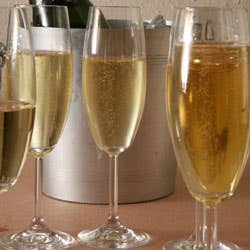
The Six Main Styles of Champagne
All French champagnes, including the Champagne region's excellent vintage wines, are classified according to a few principal designations, or styles, that denote either the types of grapes used or the amount of sugar added (the latter is contained in the dosage, the small amount of still wine added to champagne just before the cork goes into the bottle). You'll see many of the same designations on the labels of other types of sparkling wines, including some American ones.
BLANC DE BLANCS This designation applies to wines made entirely with white grapes; in the case of true French champagne (that is, wines made in the region of the same name), it translates as 100 percent chardonnay. Many blancs de blancs age exceptionally well.
BLANC DE NOIRS The name means white from blacks. Accordingly, these are light-colored champagnes made from the juice of dark-skinned grapes (pinot noir, pinot meunier, or a combination of the two for French champagne). These days, the designation is found more commonly on the labels of American sparkling wines than on those of French champagnes. Most blancs de noirs are made in the brut style (see below).
BRUT Roughly 95 percent of all French champagne is classified as brut, or dry, meaning that the dosage added to the bottle contains very little sugar. Brut champagnes encompass a wide spectrum of quality, taste, and character.
DEMI-SEC Demi-sec wines contain a dosage with a noticeable amount of sugar. These champagnes are decidedly sweet but not sappy and are the only ones that pair well with desserts (and, it's worth mentioning, wedding cake).
EXTRA-DRY In an instance of misleading nomenclature, extra-dry wines actually taste slightly sweet, as they contain a dosage with a small amount of sugar. (Adding to the confusion, the most popular extra-dry champagne, Moet & Chandon's nonvintage White Star, doesn't even include the designation on its label.) This is a popular style for sparkling wines made in the United States.
**ROSÉ **Made either by blending in a little red wine or by letting the clear grape juice come into contact with the dark grape skins, rose champagnes range in hue from pale onion skin to salmon and copper and vary widely in taste.
Keep Reading
Continue to Next Story










